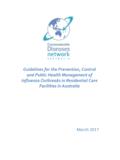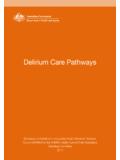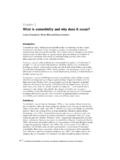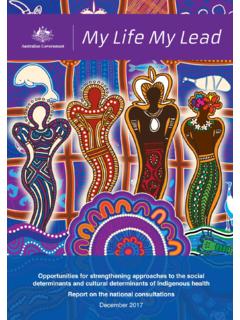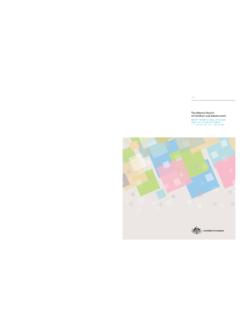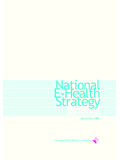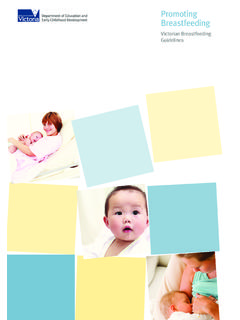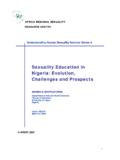Transcription of GET UP GROW - Welcome to the Department of …
1 GET UP & GROWHEALTHY EATING AND PHYSICAL ACTIVITY FOR EARLY CHILDHOODSTAFF AND CARER BOOKM inister s ForewordIt gives me great pleasure to introduce the Healthy Eating and Physical Activity Guidelines for Early Childhood Settings, an initiative that is an important element of the Australian Government s Plan for Early Childhood and Plan for Tackling Obesity. Our children s early years are arguably their most important and establishing healthy behaviours from birth will lay the foundation for lifelong health and wellbeing. Nutritious food and regular physical activity supports the normal growth and development of children and reduces the risk of developing chronic lifestyle related diseases later in more children spend time in care, early childhood settings can play an important part in supporting healthy choices around nutrition and physical activity.
2 This resource provides practical information and advice to assist practitioners, carers and families in this guidelines have been designed so that they can be applied in a variety of early childhood settings including centre-based care, family day care and preschools. They are evidence-based and consistent with current thinking on early childhood development. They will also complement a range of other programs such as the Healthy Kids Check for all four-year-olds before they start school and resources such as the Get Set 4 Life habits for healthy kids initiatives will help to ensure that all Australian children have the best possible start in life and every opportunity for the Hon Nicola Roxon Minister for Health and AgeingISBN: 1-74186-913-7 Publications Approval Number: P3-5416 Commonwealth of Australia 2009 This work is copyright.
3 Apart from any use as permitted under the Copyright Act 1968, no part may be reproduced by any process without prior written permission from the Commonwealth. Requests and enquiries concerning reproduction and rights should be addressed to the Commonwealth Copyright Administration, Attorney-General s Department , Robert Garran Offices, National Circuit, Barton ACT 2600 or posted at AND CARER BOOK1 ContentsMinister s Foreword iIntroduction 2 SECTION 1: HEALTHY EATINGB reastfeeding 5 Infant formula 11 introducing solids 14 Family foods 20 Food safety 45 SECTION 2: PHYSICAL ACTIVITYP hysical activity 53 Sedentary behaviour and screen-time 75 SECTION 3.
4 FURTHER READINGFor more information 82 Index 88 Acknowledgements 89 Staff and Carer BookGet Up & grow : Healthy eating and physical activity for early childhood provides general non-commercial, evidence-based information to early childhood education and care settings, to assist in developing healthy habits for children birth to five years. For children with particular medical or nutrition conditions, professional medical advice may be should be aware that these resources may contain images of Aboriginal and Torres Strait Islander people who are now resource has been updated to reflect the Infant Feeding Guidelines (2012) and Australian Dietary Guidelines (2013).
5 22 IntroductionThe Get Up & grow : Healthy eating and physical activity for early childhood guidelines and accompanying resources have been developed by child health and early childhood professionals in collaboration with the Australian Government Department of Health and Ageing. State and territory governments were also consulted in the development of these Get Up & grow resources are designed to be used in a wide range of early childhood settings by families, staff and carers, and to support a consistent, national approach to childhood nutrition and physical activity. When applying the guidelines and recommendations outlined within the resources, early childhood settings will also need to meet any other requirements set out in state, territory or federal regulatory healthy eating and physical activity resources are based on three key national health documents that focus on children, namely: The Infant Feeding Guidelines (2012) and the Australian Dietary Guidelines (2013), which form the basis for nutrition policy in Australia (available in Section 3: Further Reading).
6 The National Physical Activity Recommendations for Children 0 to 5 years, which has been developed to guide policy and practice around physical activity for young children (summary available at the end of Section 2: Physical Activity). GET UP & grow : HEALTHY EATING AND PHYSICAL ACTIVITY FOR EARLY CHILDHOOD3 STAFF AND CARER BOOK3 This collection of resources has also been developed in recognition of the rich cultural and religious diversity in Australia. To ensure that a range of needs were considered in the development, early childhood staff and carers, associated professionals, and parents from around Australia were consulted through surveys and focus groups. This consultation included a diverse range of people: some from urban, regional and remote locations, some with culturally and linguistically diverse backgrounds, some from Aboriginal and Torres Strait Islander backgrounds, and some who care for children with a Australia, we presently face an increasing problem with overweight and obese children.
7 The intention of these resources is not to specifically target overweight and obesity, but to establish healthy lifestyle habits in children, in particular healthy habits for eating and physical activity. In turn, this will contribute to the prevention of weight problems in children, while promoting optimum growth, addressing other health issues such as dental health, and allowing children to thrive through social, physical and intellectual UP & grow : HEALTHY EATING AND PHYSICAL ACTIVITY FOR EARLY CHILDHOODThe goal of the healthy eating guidelines is to promote offering healthy food choices to children (whether food is provided in the setting or brought from home), while also encouraging children to eat to their own appetites, develop positive attitudes toward selecting food and enjoy eating.
8 The goal of the physical activity recommendations is to support making play a priority, and encourage early childhood staff, carers and families to provide frequent play opportunities in a positive Staff and Carer Book is one of the four Get Up & grow resource books, and is designed for staff and carers at early childhood settings. It provides: an understanding of the healthy eating guidelines and physical activity recommendations practical ideas for putting the guidelines into practice and for working with families confidently. As well as the four resource books (Director/Coordinator Book, Staff and Carer Book, Family Book and Cooking for Children), there are additional Get Up & grow materials, such as posters and stickers for the setting, flyers for parents, and newsletter inserts.
9 Staff and carers are with children in early childhood settings every day, and have an important role in children s development. The information in this book will act as a guide for encouraging children and families to get up and grow ! ..provide frequent play opportunities in a positive environment. 5 STAFF AND CARER BOOK5 Section 1: Healthy EatingBreastfeeding is the first food experience for most babies. Breastmilk has all the nutrients a baby needs, and is the only food required until around six months. Ideally, babies will continue to enjoy and benefit from breastfeeding until at least 12 months, or longer if the mother and baby fourth guideline of the Australian Dietary Guidelines is Encourage, support and promote breastfeeding .
10 Australia s breastfeeding initiation rate in 2010 was high at 96%, however only 15% of infants were exclusively breastfed to around six EATING GUIDELINEE xclusive breastfeeding is recommended, with positive support, for babies until around six months. Continued breastfeeding is recommended for at least 12 months and longer if the mother and baby Perfect for babiesThe benefits of breastfeeding for babies: Breastmilk contains the appropriate nutrients for babies during each stage of their development. Breastmilk helps to protect young babies from diseases, particularly gastro-intestinal, respiratory and middle-ear infections. The sucking actions of breastfeeding help shape and prepare the jaw for teeth and speech. Safe handling of breastmilk Babies should only drink breastmilk that has come from their own mother.
